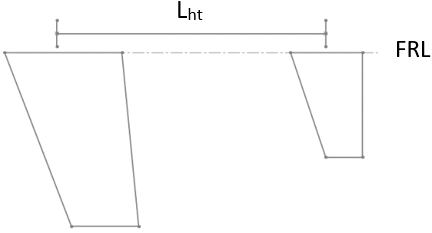This set of Aircraft Design Multiple Choice Questions & Answers (MCQs) focuses on “Geometry Sizing”.
1. The purpose of fuselage is ___________
a) to provide space for cargo and passenger
b) to provide thrust
c) to provide high lift
d) to increase maximum lift
View Answer
Explanation: Main body of the aircraft is called fuselage. Fuselage is used to provide space for cargo, crew and passenger. Thrust is primarily provided by engines. High lift is generated through high lift devices.
2. Fineness ratio of fuselage is ratio of _____________
a) fuselage length and maximum diameter
b) fuselage diameter
c) fuselage diameter and maximum length
d) length of fuselage and weight
View Answer
Explanation: Fineness ratio is defined as the length of the fuselage to the maximum diameter of the fuselage. If fuselage has a different cross section then, equivalent diameter is used for fineness ratio.
3. An aircraft is flying with fuselage having length of 1.5m and fineness ratio of 15. At which maximum diameter fuselage should be designed?
a) 0.1m
b) 0.25m
c) 5m
d) 20.5m
View Answer
Explanation: Given, fuselage fineness ratio F=15, length l=1.5m
Now, diameter D = l/F = 1.5/15 = 0.1m.
4. Jet transport aircraft has 12m length of the fuselage. What will be the approximated value for take-off gross weight?
a) 820.68kg
b) 850kg
c) 520kg
d) 1025g
View Answer
Explanation: Given, length L=12m
Now, length is given by,
L = a*W0c
Now, for jet transport aircraft a=0.67, c=0.43
Hence, take-off gross weight is W0c = L/a
W00.43 = 12/0.67 = 17.91.
Now by taking log at both side,
0.43*ln W0 = ln17.91 = 2.885
lnW0 = 6.710
Hence, by using antilog,
W0 = e6.710 = 820.68kg.
5. A jet fighter has take-off gross weight of 10000 units. Find the appropriate length of the fuselage.
a) 34 unit
b) 34.5
c) 35 unit
d) 35.65
View Answer
Explanation: Given, take-off gross weight is W0 = 10000 unit.
Now, length is given by,
L = a*W0c
Now, for jet fighter aircraft a=0.93, c=0.39
Hence, length of fuselage is,
L = 0.93*100000.39 = 33.76 = 34unit.
6. Find the wing reference area if wing loading is 85 lb/ft2 and aircraft has gross weight of 10000 lb.
a) 117.64 ft2
b) 112.65 ft2
c) 152 ft2
d) 125 ft2
View Answer
Explanation: Given, take-off gross weight is W0 = 10000 lb, wing loading W.L. = 85 lb/ft2
W.L. = W0/area, area = W0/ W.L. = 10000/85 = 117.64 ft2.
7. The distance marked by ‘Lht’ represents _____

a) tail moment arm
b) tail area
c) fuselage area
d) wing length
View Answer
Explanation: Above diagram is showing a typical plan view of a wing tail configuration. Lht represents distance between wing aerodynamic center and the tail aerodynamic center of MAC. It is known as the tail moment arm.
8. Which of the following is correct for vertical tail (VT)?
a) Cvt = Lvt*Svt/(bwing*Swing)
b) Cvt = Lvt/(bwing*Swing)
c) Cvt = Svt/(bwing*Swing)
d) Cvt = Lvt*Svt
View Answer
Explanation: For vertical tail Cvt represents tail volume coefficient. It is used for sizing purpose. By adequate selection of it will provide require surface area of the tail. Cvt is given by, Cvt = Lvt*Svt / (bwing*Swing).
9. If Cvt = 0.05 then, find the vertical tail area. Given wing span b is 2m, wing area S=10m2 and tail moment arm Lvt=1m.
a) 1m2
b) 1cm2
c) 1in2
d) 1.2cm2
View Answer
Explanation: Given, Cvt=0.05, b = 2m and wing area S=10m2.
Tail moment arm Lvt is directly given so Lvt=1m.
Now, tail area Svt is given by,
Svt = Cvt*b*S/Lvt = 0.05*2*10/1 = 1m2.
10. If length of typical fuselage is 20m then, find the approximate range for control canard moment arm.
a) 6m-10m
b) 2-5cm
c) 5-9in
d) 11-20m
View Answer
Explanation: Given a typical fuselage with length L = 20m.
Typical range for canard (control) moment arm = 30% to 50% of the length
= 30% of L to 50% of L = 30% of 20 to 50% of 20
= 0.3*20 to 0.5*20 = 6m – 10m.
11. A typical jet transport aircraft needs to be sized based on following parameters. Wing area S=50m2, MAC=5m. If tail volume coefficient of horizontal tail is 1 and tail area is 10m2 then, find the required tail moment arm.
a) 25m
b) 50m
c) 25cm
d) 65in
View Answer
Explanation: Given, wing area S=50m2, MAC=5m.
Sanfoundry Global Education & Learning Series – Aircraft Design.
To practice all areas of Aircraft Design, here is complete set of 1000+ Multiple Choice Questions and Answers.
If you find a mistake in question / option / answer, kindly take a screenshot and email to [email protected]
- Practice Aeronautical Engineering MCQs
- Apply for Aerospace Engineering Internship
- Check Aeronautical Engineering Books
- Check Aerospace Engineering Books
- Check Aircraft Design Books
